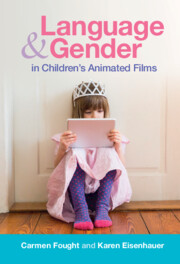Book contents
- Language and Gender in Children’s Animated Films
- Language and Gender in Children’s Animated Films
- Copyright page
- Dedication
- Contents
- Figures
- Tables
- Preface
- Acknowledgments
- 1 Introduction
- 2 Gender, Disney, and Pixar in Historical Context
- 3 Representation, Speech Amounts, and Talkativeness
- 4 Compliments
- 5 Directives
- 6 Insults
- 7 Apologies
- 8 Representing Queerness
- 9 Conclusion
- References and Filmography
- Index
3 - Representation, Speech Amounts, and Talkativeness
Published online by Cambridge University Press: 01 September 2022
- Language and Gender in Children’s Animated Films
- Language and Gender in Children’s Animated Films
- Copyright page
- Dedication
- Contents
- Figures
- Tables
- Preface
- Acknowledgments
- 1 Introduction
- 2 Gender, Disney, and Pixar in Historical Context
- 3 Representation, Speech Amounts, and Talkativeness
- 4 Compliments
- 5 Directives
- 6 Insults
- 7 Apologies
- 8 Representing Queerness
- 9 Conclusion
- References and Filmography
- Index
Summary
This chapter presents an overview of the presence of male and female characters and speech, in each film and across the entire set of films, and discusses issues of representation, conversational dominance, and talkativeness. In the Disney Princess films, male characters and male speech are both overrepresented. While Disney’s branding talks a big game about progressive feminist values, the films still consistently under-represent female characters, and reinforces the expectation that women should speak less than men. While Pixar also overrepresents male characters, at times even more drastically than Disney does, analysis of male and female co-leads showed neither gender consistently talking over the other. This suggests that Pixar has an issue of attention: when Pixar focuses on writing women, the result is a diverse set of talkative, well-rounded female characters with varying levels of power and assertion within their relationships. However, the presentation of femininity outside these one or two characters in each film tends to be much lazier, or altogether missing in favor of a host of male background characters. In films from both studios, male characters consistently take up more space, both in aggregate and in individual conversations, but the framing and characterization of talkativeness suggests that it’s women who are emotional, gossipy, and overly talkative.
Keywords
- Type
- Chapter
- Information
- Language and Gender in Children's Animated FilmsExploring Disney and Pixar, pp. 44 - 75Publisher: Cambridge University PressPrint publication year: 2022

